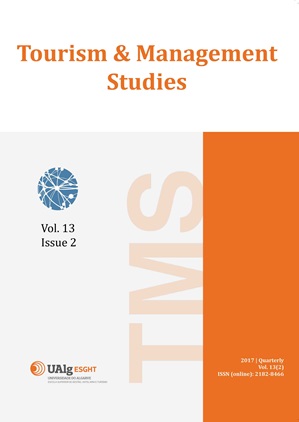How can brand equity for tourism destinations be used to preview tourists’ destination choice? An overview from the top of Tower of Babel
Keywords:
Brand equity, destination choice, dream destination, favourite destinationAbstract
Customer-based brand equity for tourism destinations (CBBE-TD) is a helpful construct to assess destination branding effectiveness. However, it would be even more useful if it could be integrated into a wider methodological approach articulating destination brand assessment with the destination choice process. This paper describes a new research programme – Favourite Destinations Worldwide – that includes three interrelated innovative tools: (1) the destination brand choice model that allows a better conceptualization of CBBE-TD in the context of destination choice; (2) the Tower of Babel platform, a multilingual online survey for data gathering, to assess CBBE-TD of all destinations competing in the world market; and (3) the Destination Brand Gnosis, a propriety software for qualitative data analysis, transforming the meta-data into a system for constantly evaluating brand attractiveness. Additionally, for illustrative purposes empirical data from two national samples is presented: Portuguese (N = 524) and Brazilian (N = 955). Besides presenting the preferred destination brands for Brazilian and Portuguese tourists, the results confirm a basic assumption supporting this research program related to the geographic polarization of the most valued destination brands: “dream destination brands” correspond to destinations located farther from respondents’ home-places, in other continents, requiring long-haul air travel, while “favourite destination brands” are predominantly destinations located nearer, in respondents’ own countries or neighbouring countriesReferences
Aaker, D. A. (1991). Managing brand equity. New York: The Free Press.
Aaker, D. A. (1996). Building strong brands. New York: The Free Press.
Blain, C., Levy, S. E., & Ritchie, R. B. (2005). Destination branding: insights and practices from destination management organizations. Journal of Travel Research, 43, 328-338.
Blut, M., Evanschitzky, H., Vogel, V., & Ahlert, D. (2007). Switching
Barriers in the Four-Stage Loyalty Model. Advances in Consumer Research Volume, 34, 726-734.
Botha, C., Crompton, J. L., & Kim, S. (1999). Developing a Revised Competitive Position for Sun/Lost City, South Africa. Journal of Travel Research, 37 (3), 341-352.
Buhalis, D. (2000). Marketing the competitive destination of the future. Tourism Management, 21, 97?116.
Charmaz, K. (2014). Constructing grounded theory, 2nd Edition. Sage, London.
Crouch, G. I., & Ritchie, J. R. B. (2012). Competitiveness and Tourism, Vol. I. Edward Elgar Publishing, Northampton.
Decrop, A. (2010). Destination choice sets: an inductive longitudinal approach. Annals of Tourism Research, 37(1), 93-115.
Driscoll, A., Lawson, R., & Niven, B. (1994). Measuring Tourists’ Destination Perceptions. Annals of Tourism Research, 21(3), 499-51.
Dupeyras, A., & MacCallum, N. (2013). Indicators for Measuring Competitiveness in Tourism: A Guidance Document, OECD Tourism Papers, No. 2013/02, OECD Publishing, Paris.
Javalgi, R. G., Thomas, E. G., & Rao, S. R. (1992). US Pleasure Travellers’ Perceptions of Selected European Destinations. European Journal of Marketing, 26 (7), 45-64.
Keller, K. L. (1993). Conceptualizing, measuring, and managing customer?based brand equity. Journal of Marketing, 57, 1?22.
Keller, K. L. (2008). Strategic Brand Management: Building, Measuring and Managing Brand Equity, 3rd ed., Ney Jersey: Pearson Education.
Keller, K. L. (2009). Building strong brands in a modern marketing communications environment. Journal of Marketing Communications, 15(2?3), 139?155.
Keller, K. L. (2016). Reflections on customer-based brand equity: perspectives, progress, and priorities. AMS Review, 6 (1), 1-16.
Keller, K. L., & Lehmann, D. R. (2003). The brand value chain: Optimizing strategic and financial brand performance. Marketing Management (May/June), 26-31.
Kim, J. H. (2010). Determining the factors affecting the memorable nature of travel experiences. Journal of Travel & Tourism Marketing, 27(8), 780-796.
Konecnik, M., & Gartner, W. C. (2007). Customer-based Brand Equity for a Destination. Annals of Tourism Research, 34(2), 400-421.
Kotler, P. & Armstrong, G. (2008). Principles of Marketing. Upper Saddle River, NJ: Prentice Hall.
Kozak, M., & Rimmington, M. (1999). Measuring Tourist Destination Competitiveness: Conceptual Considerations and Empirical Findings. Hospitality Management, 18(3), 273–283.
Larsen, S. (2007). Aspects of a psychology of the tourist experience. Scandinavian Journal of Hospitality and Tourism, 7(1), 7- 18.
Leung, X. Y; & Baloglu, S. (2013). Tourism Competitiveness of Asia Pacific Destinations. Tourism Analysis, 18 (4), 371-384.
Oliver, R. L. (1997). Satisfaction: A behavioural perspective of the consumer. New York: Irvin/McGraw?Hill.
Oliver, R. L. (1999). Whence Consumer Loyalty? Journal of Marketing, 63 (Special Issue), 33?44.
Oppewall, H; Huybers, T; & Crouch, G. I. (2015). Tourist destination and experience choice: A choice experimental analysis of decision sequence effects. Tourism Management, 48, 467–476.
Pike, S. (2004). Destination marketing organizations. Advances in tourism research series. New York: Elsevier.
Strauss, A., & Corbin, J. (1998). Basics of Qualitative Research: Techniques and Procedures for Developing Grounded Theory. 2nd ed., London: SAGE Publications.
Tung, V. W. S., & Ritchie, J. R. B. (2011). Exploring the essence of memorable tourism experiences. Annals of Tourism Research, 38(4), 1367-1386.
Um, S., & Crompton, L. (1990). Attitude determinants in tourism destination choice. Annals of Tourism Research, 17, 432-448.
Vazquez, R., Belen del Rio, A., & Iglesias, V. (2002). Consumer-based brand equity: development and validation of a measurement instrument. Journal of Marketing Management 18, 27–48.
Woodside, A. G., & Lysonski, S. (1989). A General Model of Traveler Destination Choice. Journal of Travel Research, Spring, 8-14.
Yang, Y; Liu, X. & Li, J (2015). How Customer Experience Affects the Customer-Based Brand Equity for Tourism Destinations. Journal of Travel & Tourism Marketing, 32, 97-113.
Downloads
Published
Issue
Section
License
Copyright (c) 2017 Tourism & Management Studies

This work is licensed under a Creative Commons Attribution-NoDerivatives 4.0 International License.
The journal retains published articles’ copyrights, but they are simultaneously licensed under the Creative Commons Attribution License (CC BY-NC-ND), which allows individuals’ to share the relevant papers as long as authorship and publication in this journal are duly acknowledged.



